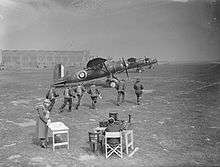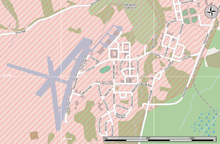400 Tactical Helicopter Squadron
| No. 400 Tactical Helicopter Squadron | |
|---|---|
| Active |
5 October 1932 - 7 August 1945 15 April 1946 - Present |
| Country |
|
| Allegiance |
|
| Branch | Royal Canadian Air Force |
| Role | Tactical Helicopter and Training |
| Motto(s) |
Latin: Percussuri Vigiles (On the watch to strike) |
| Battle honours | Fortress Europe 1941-44, Dieppe, France and Germany 1944-45, Normandy 1944, Arnhem, Rhine, Biscay 1942-43 |
| Insignia | |
| Squadron Badge heraldry | In front of two Tomahawks in solitire an eagle's head erased |
400 "City of Toronto" Tactical Helicopter and Training Squadron is part of 1 Wing, and as such a lodger unit of Canadian Forces Base Borden. The squadron operates the CH-146 Griffon.
History

The squadron was formed as No. 10 Army Co-Operation Squadron at Toronto, Ontario on 5 October 1932. On 15 November 1937, it was renumbered No. 110 "City of Toronto" Army Co-Operation Squadron.
The squadron was called out on active service 3 September 1939 at the start of the Second World War, and on 15 February departed Halifax for England. There it was re-designated as No. 400 Army Co-Operation Squadron on the 1 March 1941 in recognition of the fact it was the first squadron to deploy overseas.
During the war, it flew the Westland Lysander, P-40 Tomahawk, P-51 Mustang, de Havilland Mosquito and Supermarine Spitfire primarily in the armed and unarmed reconnaissance role. Later in the war, the squadron also flew air interdiction operations. At the end of the war, 400 Squadron was disbanded on 7 August 1945, at a captured airfield in Lüneburg, Germany.
No. 400 Squadron reformed at RCAF Station Downsview, Toronto on 15 April 1946 as an Auxiliary Fighter-Bomber Squadron operating North American Harvard Mk IIBs commanded by S/L G.W. Gooderman, A.F.C. At the start of the Cold War the squadron flew the de Havilland Vampire Mk IIIs and then F-86 Sabre Mk V aircraft. No. 400 "City of Toronto" (Fighter) Squadron, as part of 2 Air Reserve Wing, first flew Beechcraft Expeditor starting in 1958 and then the DHC Otter in 1960. These aircraft were flown throughout the 1960s and 1970s.
Unification of the Canadian Forces brought about another name change, this time to 400 "City of Toronto" Air Reserve Squadron. In 1980, the conversion to helicopters began with the CH-136 Kiowa. The squadron received its current name in the 1980s, becoming 400 Tactical Helicopter and Training Squadron. The squadron moved to CFB Borden in 1996 after the closure of CFB Downsview (Toronto), and is now equipped with the CH-146 Griffon.
During peacetime, the squadron fulfills 1 Wing commitments by providing operational and training support to the 4th Canadian Division, the defence of Canadian sovereignty, support to national taskings, and support to peacekeeping operations. Its secondary duties are to support AIRCOM's search and rescue operations.

In the unlikely event that the nation mobilizes for war, 400 Tactical Helicopter and Training Squadron will deploy all of its aviation assets, including support equipment, to augment 427 Special Operations Aviation Squadron in Petawawa. Those personnel remaining behind will form the core of a forces generation unit.
400 Tactical Helicopter and Training Squadron has an establishment of 237 personnel divided into six flights:
- 3 flying flights
- 1 maintenance flight
- 1 administrative support flight
- 1 squadron headquarters flight
The HQ Flight is a conglomeration of the Orderly Room, Finance Section, Medical Section and the 400 Squadron Pipes and Drums Band.
References
On Watch to Strike, History of 400 (City of Toronto) Squadron, 1932 to 1996
External links
| Wikimedia Commons has media related to 400 Squadron RCAF. |